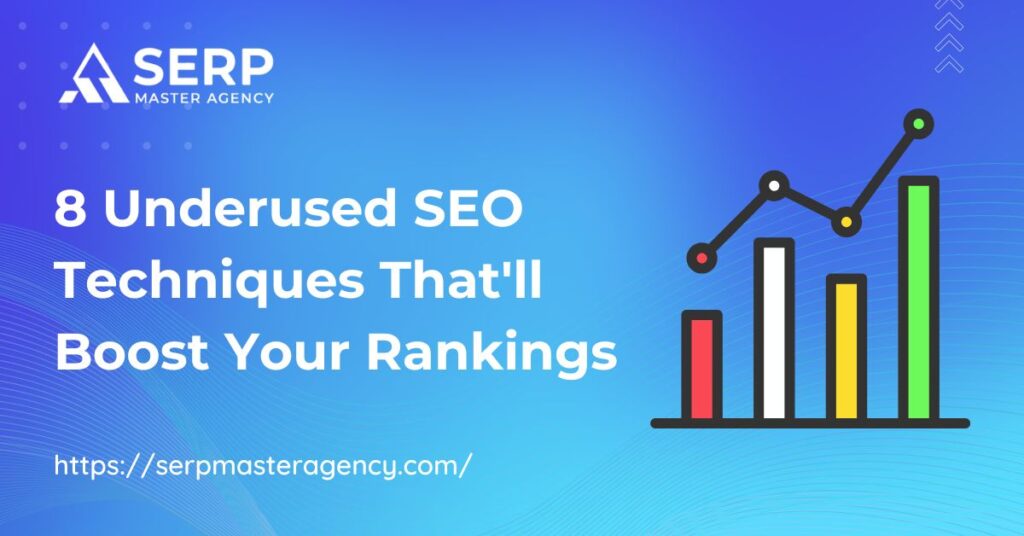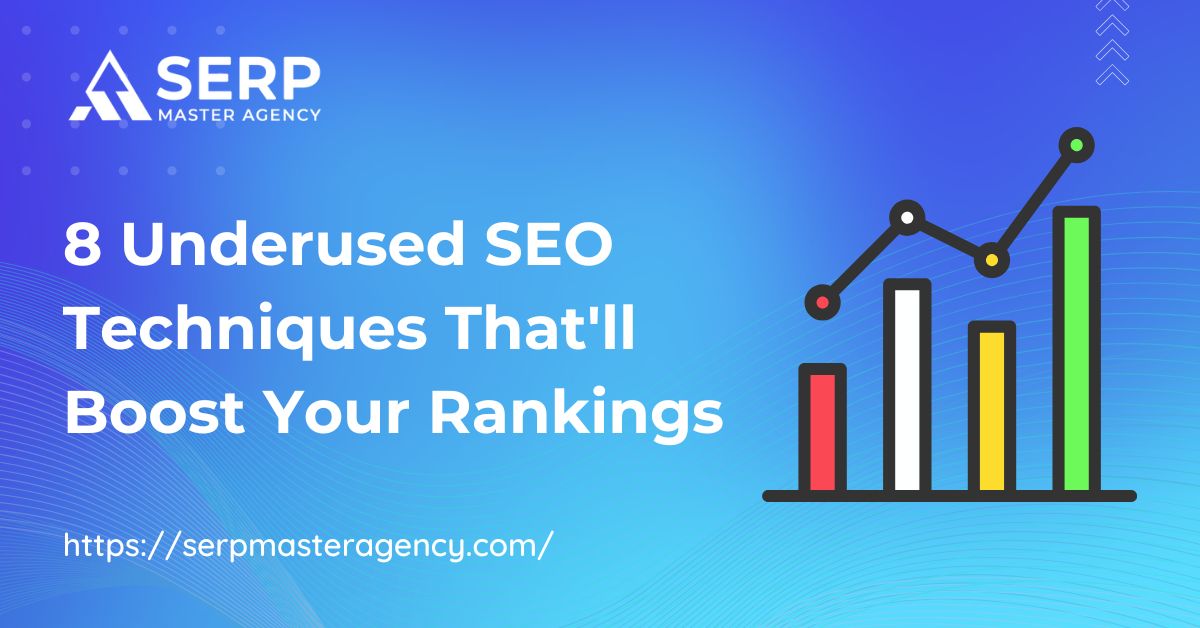Boosting your website’s rankings seems like an insurmountable task, with every digital marketer striving to climb the elusive ladder of search engine results.
However, what if I told you there are eight often overlooked SEO techniques that could be the key to unlocking higher rankings and increased visibility for your online presence?
By exploring these underused strategies, you might just uncover the hidden gems that could propel your website to new heights in the competitive online landscape.
Key Takeaways
- Implement schema markup for enhanced search engine rankings and improved visibility.
- Use long-tail keywords strategically to target specific user needs and questions for higher conversion rates.
- Optimize website performance by enhancing site speed and user engagement to positively impact SEO rankings.
- Incorporate advanced techniques like voice search optimization and building quality backlinks to further boost online visibility and rankings.
Schema Markup Implementation
Implementing Schema Markup on your website can significantly enhance your search engine rankings by providing search engines with structured data to better understand your content.
By incorporating Schema Markup, you enable search engines to display rich snippets, which are enhanced search results that provide users with more information directly on the search engine results page. Rich snippets can include elements like star ratings, pricing information, and product availability, making your website more attractive and informative to potential visitors.
Structured data plays a crucial role in improving your SEO rankings by enhancing the relevance and visibility of your content to search engines.
Search engines rely on structured data to interpret the context and meaning of your web pages, which can lead to higher rankings in search results.
Image Optimization Beyond Alt Tags
Enhancing your website’s SEO performance goes beyond Schema Markup implementation; delving deeper into image optimization strategies can further propel your rankings by maximizing visual content impact. When it comes to image optimization, utilizing techniques such as image compression and ensuring browser compatibility are crucial for enhancing user experience and SEO ranking. Image SEO, coupled with responsive design and a focus on local SEO services, plays a significant role in improving your website’s performance across different devices and platforms.
To provide a clearer understanding, let’s delve into a table showcasing the importance of image optimization techniques:
| Image Optimization Techniques | Benefits | Implementation |
| Image Compression Techniques | Reduces load times | Use tools like TinyPNG or ImageOptim for compression |
| Browser Compatibility | Ensures consistent display | Test images across various browsers for compatibility |
| Responsive Design | Enhances user experience | Opt for responsive themes and design elements |
Internal Linking Strategies
To optimize your website’s SEO performance effectively, internal linking strategies play a crucial role in enhancing user engagement and improving search engine visibility. When implementing internal linking, consider utilizing a strategic anchor text strategy.
Anchor text serves as a clickable text in a hyperlink, providing context to both users and search engines about the linked content. Choose anchor texts that are relevant to the linked page’s topic and incorporate important keywords for SEO benefits.
By strategically interlinking relevant pages within your site, you create a web of connections that not only guides users to valuable content but also helps search engines crawl and index your website more effectively. This internal linking technique can enhance the overall user experience by offering additional resources and information where needed, ultimately boosting user engagement metrics.
Furthermore, internal linking can help distribute link equity throughout your site, potentially improving the ranking of important pages in search engine results. By incorporating a well-thought-out anchor text strategy and mastering internal linking techniques, you can positively impact your website’s SEO performance and visibility.
Capitalizing on Long-Tail Keywords
Utilize a targeted approach to leverage long-tail keywords for maximum SEO impact. Long-tail keywords are specific keyword phrases that typically have lower search volumes but higher conversion rates compared to broader keywords.
Conduct thorough keyword research to identify relevant long-tail keywords that align with your content and target audience. By incorporating these long-tail keywords strategically into your content creation, you can increase your website’s visibility and attract more qualified traffic.
When focusing on long-tail keywords, consider the intent behind each search query. Tailor your content to address the specific needs or questions that users may have when using these long-tail terms. This targeted approach not only improves your chances of ranking higher in search engine results pages but also enhances the overall user experience on your website.
Enhancing Site Speed and Performance
With a focus on optimizing your website’s speed and performance, you can significantly impact your SEO rankings and user experience. Two crucial aspects to consider are improving caching and reducing redirects.
By enhancing caching mechanisms, you enable your website to store frequently accessed data, leading to faster loading times and improved user satisfaction. Similarly, minimizing redirects helps streamline the user journey on your site, reducing wait times and enhancing overall performance.
To further emphasize the importance of these strategies, let’s take a look at the following data-driven table showcasing how improving caching and reducing redirects can positively influence your site’s speed and performance:
| Metric | Before Optimization | After Optimization | Improvement |
| Page Load Time | 8.5 seconds | 3.2 seconds | 62% |
| Server Response Time | 150 ms | 75 ms | 50% |
| Number of Redirects | 4 | 1 | 75% |
Leveraging Social Media for SEO
Utilize social media channels strategically to harness the power of social signals for SEO.
Increase engagement through compelling content to boost visibility and drive traffic to your website.
Enhancing your social media presence can have a significant impact on your search engine rankings.
Social Signals Impact
Leveraging social media channels strategically can significantly impact your SEO rankings by amplifying signals that search engines consider when evaluating website relevance and authority. To maximize the benefits of social media impact on SEO, consider the following:
- Engagement Metrics: Track likes, comments, shares, and click-through rates to gauge audience interest.
- Consistent Posting: Regularly share high-quality content to maintain visibility and engagement.
- Platform Relevance: Tailor your content to suit each social media platform’s audience and algorithms.
- Influencer Partnerships: Collaborate with influencers to widen your reach and increase social signals correlation.
Engagement Boosts Visibility
Engagement on social media platforms directly correlates with increased visibility, enhancing your website’s SEO performance through amplified audience interactions and signal reinforcement. To leverage this effectively, focus on creating interactive content that encourages user participation and boosts video engagement.
By incorporating these elements into your social media strategy, you can drive higher levels of engagement, leading to improved visibility and organic traffic. Here is a breakdown of the key factors to consider:
| Factors | Description |
| Interactive Content | Create polls, quizzes, and contests to engage users. |
| Video Engagement | Utilize videos to captivate your audience and increase interaction. |
| User Feedback | Encourage comments and responses to foster community engagement. |
| Shareability | Craft shareable content that resonates with your audience. |
| Call-to-Actions | Include clear CTAs to prompt users to engage further. |
Optimizing for Voice Search
To boost your rankings, optimizing for voice search is crucial.
With the rise of voice-activated devices, incorporating voice search into your SEO strategy can significantly enhance your online visibility.
Understanding and implementing SEO techniques tailored for voice searches can give you a competitive edge in the digital landscape.
Voice Search Optimization
With the increasing prevalence of voice search usage, optimizing your SEO strategy for voice is crucial in enhancing your website’s visibility and ranking. When targeting voice search, focus on incorporating natural language and understanding conversational queries.
By aligning your content with how people speak, you can better cater to voice search algorithms and user behavior. Consider the following data-driven strategies to improve your SEO for voice:
| SEO for Voice | Action |
| Use Long-Tail Keywords | Optimize for phrases people use in natural conversations. |
| FAQ Page Optimization | Structure content to answer common questions concisely. |
| Local SEO Importance | Ensure your business information is accurate for local voice searches. |
| Schema Markup | Implement schema to provide context to search engines for voice queries. |
Building Quality Backlinks
When aiming to enhance your website’s SEO performance, the strategic acquisition of high-quality backlinks plays a pivotal role in elevating your search engine rankings. Here are some key strategies to help you effectively build quality backlinks:
- Leverage Guest Posting Opportunities: Seek out reputable websites within your niche that accept guest posts. By contributing valuable content to these platforms, you can include backlinks to your site, increasing its visibility and credibility.
- Implement Link Building Outreach: Proactively reach out to relevant websites and blogs to request backlinks. Personalized outreach can help you establish mutually beneficial relationships and secure valuable backlinks from authoritative sources.
- Focus on Quality over Quantity: Prioritize acquiring backlinks from high-authority websites with relevant content. Quality backlinks from trustworthy sources carry more weight in improving your site’s SEO performance.
- Monitor and Analyze Backlink Performance: Regularly track the performance of your backlinks using tools like Google Analytics. Analyze metrics such as referral traffic and domain authority to assess the impact of your link-building efforts and make adjustments as needed.
Frequently Asked Questions
How Does Schema Markup Implementation Impact Overall SEO Rankings and Visibility?
Implementing schema markup positively impacts SEO rankings and visibility by enhancing your website’s structured data, making it easier for search engines to understand and display your content, increasing the likelihood of being featured in rich snippets.
What Are Some Advanced Image Optimization Techniques That Go Beyond Just Adding Alt Tags?
You’re missing out on a goldmine with advanced image optimization tricks. Dive into advanced image compression techniques for faster loading times. Implement image lazy loading for improved user experience and better SEO rankings. Your site deserves it.
How Can Internal Linking Strategies Improve User Experience and Search Engine Crawlers’ Understanding of Website Content?
To enhance user experience and SEO, utilize anchor text optimization for internal linking. By implementing content siloing and refining site structure, you foster user engagement and aid search engine crawlers in better understanding your website’s content.
What Are Some Effective Ways to Capitalize on Long-Tail Keywords to Drive Targeted Organic Traffic?
To drive targeted organic traffic through long-tail keywords, you must delve deep into keyword research and analyze competition. Optimize content with user intent in mind. By crafting strategic, data-driven content, you can outsmart the competition and attract valuable visitors.
How Does Enhancing Site Speed and Performance Contribute to Better Search Engine Rankings and User Engagement on a Website?
Enhancing site speed and performance significantly impacts your SEO rankings and user engagement. Faster load times boost user experience, reducing bounce rates and increasing website conversions. Prioritize optimization to align with search engine algorithms for better visibility and results.
Conclusion
In conclusion, implementing these underused SEO techniques can significantly boost your website’s rankings and visibility in search engine results.
By incorporating schema markup, optimizing images, focusing on long-tail keywords, improving site speed, leveraging social media, optimizing for voice search, and building quality backlinks, you can drive more traffic and increase your online presence.
Remember, in the world of SEO, it’s not about working harder, but working smarter to reach the top of the digital mountain.

Suraj Rana is a highly regarded SEO expert specializing in the dental industry. His expertise lies in crafting strategic SEO marketing plans to help new or expanding businesses increase their online visibility and attract more customers. Suraj Rana’s skills extend to improving website rankings and boosting organic search visibility, thereby enhancing web traffic and return on investment for businesses.



